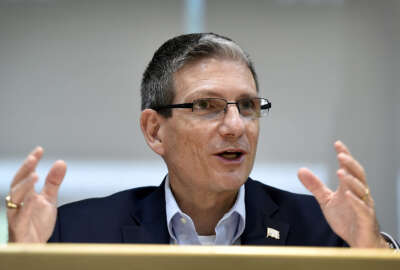Lawmakers see paid family leave, more federal interns as viable ideas to improve talent pipeline
As House lawmakers search for ways to help the federal government strengthen its talent pipeline, they find consensus on at least two ideas.
Best listening experience is on Chrome, Firefox or Safari. Subscribe to Federal Drive’s daily audio interviews on Apple Podcasts or PodcastOne.
When it comes to injecting more young, fresh talent into the federal workforce, it’s no secret by now that agencies are far behind.
Just 6% of the federal workforce in 2018 was under the age of 30, compared to roughly 21% in the private sector.
By now, members of Congress have plenty of ideas — big and small — before them about how to build a healthy federal talent pipeline.
“As we move forward we’re going to have to prioritize, pending some comprehensive redo [or] restructure of the system,” Rep. Gerry Connolly (D-Va.), chairman of the government operations subcommittee, said Wednesday at a hearing on recruiting and retaining the next generation of federal employees.
A comprehensive restructuring of the civil service system is the elephant in the room.
But the subcommittee on Wednesday didn’t come to any major, enlightening revelations about how to, for example, revamp the federal hiring process or overhaul the General Schedule, which will celebrate its 70th birthday next month.
But members did, in a sense, develop a priority list of perhaps more doable solutions they could tackle to help government address its talent pipeline challenges.
More federal interns
Improving the federal internship, or Pathways Program, appears to be first on the list.
Agencies once hired 35,000 interns in 2010. But in 2018, agencies only hired 4,000 of them, according to the president’s 2020 budget request.
The Office of Management and Budget is trying to address the nosedive in new student internship hires. For Connolly, the stark drop in new student interns is concerning, because it means the next generation isn’t getting an initial taste of federal service.
“There’s no systematic mentorship,” Connolly said of the federal internship program. “There’s no guaranteed rotation around an agency so you get exposed to the different missions and maybe [you can] pick one you like. There’s no debriefing or exit interview when you’ve had your internship to make sure it went well. There are no criteria for what happens. And as a result … a very low percentage of federal interns end up joining the federal workforce. This is one right in front of us, right? They’re interning. That is, it seems to me, our first resource, and we’re not using it.”
Both the Government Accountability Office and the Partnership for Public Service agreed.
Workforce planning has already been a challenge for agencies, and internships generally aren’t part of that planning, said Margot Conrad, director for federal recruiting and hiring programs at the Partnership.
Related Stories
Federal paid family leave
Paid family leave may be another priority for lawmakers and federal employee organizations.
“This is absolutely essential for young workers,” Rep. Carolyn Maloney (D-N.Y.), who has been working on federal paid leave program for the past 20 years. “Both the man and the woman are working, the mother and the father are working. Both incomes are needed to make ends meet for most families.”
Maloney introduced the Federal Employee Paid Leave Act (FELPA) in March. The bill would provide up to 12 weeks of paid leave for federal employees to witness the birth, adoption or fostering of a new child and care for a new child or family member with a serious medical condition.
The Institute for Women’s Policy Research estimated agencies could prevent 2,650 departures a year among women workers by offering paid family leave, saving $50 million annually in turnover costs.
The 20 largest private sector companies offer some form of paid family leave for their employees. Both the National Treasury Employees Union and the Heritage Foundation say government should join this growing trend.
“Since employer-provided policies are best for workers, it makes sense for the federal government to provide paid family leave to its workers,” Rachel Greszler, research fellow for the Heritage Foundation, said. “But such a policy should replace the current, de-facto paid leave policy that exists through unlimited sick leave accumulation, as well as six weeks of advanced sick leave.”
Latest Workforce News
A motion from Sen. Brian Schatz (D-Hawaii) to insist conferees discuss the federal paid family leave proposal failed Wednesday in a series of votes on the Senate floor, but lawmakers may still discuss the matter in conference.
Preserve existing benefits
For NTEU, preserving telework flexibilities and enhancing student loan repayment programs, benefits that federal employees technically already have, are the best ways to attract and retain young workers.
Avoiding another government shutdown would help too, NTEU National President Tony Reardon said.
“The mere fact that we have to fight so hard and so often for these basic things takes its toll on the workers that I represent,” he told the subcommittee. “They are in a constant state of uncertainty and that has a significant impact on morale and on the government’s ability to recruit and retain talented employees.”
The Departments of Agriculture, Education, Health and Human Services and Interior have all made changes to their telework policies over the past year or so.
“There’s this whole notion that some managers have that if I can’t see you, how do I know that you’re working? That needs to be overcome,” Robert Goldenkoff, GAO director of strategic issues, said. “So long as that’s pervasive, telework won’t expand.”
While Connolly and other members expressed a sense of urgency around preserving and enhancing federal workforce telework programs, Rep. Mark Meadows (R-N.C.), the subcommittee’s ranking member, wanted to focus on the elephant in the room.
Will federal employees even go for a complete overhaul of the General Schedule?
“So is it barking up the wrong tree?” Meadows asked.
“It may be,” Reardon said. “I’m willing to listen. I am absolutely willing to listen. But what I’m passing along to you is that my members, and I personally, believe that there is a system in place that would work if it was properly utilized.”
“That’s where probably fundamentally we disagree, but that’s okay,” Meadows said.
Copyright © 2024 Federal News Network. All rights reserved. This website is not intended for users located within the European Economic Area.
Nicole Ogrysko is a reporter for Federal News Network focusing on the federal workforce and federal pay and benefits.
Follow @nogryskoWFED








